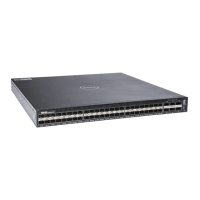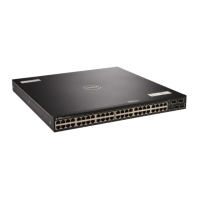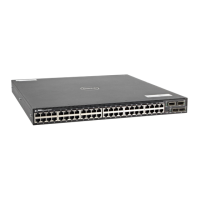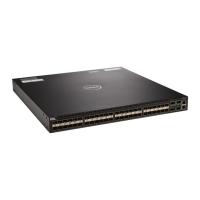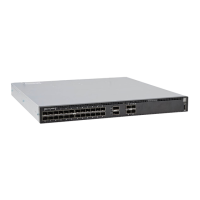• When WRED is configured on the global service-pool (regardless of whether ECN on global service-
pool is configured), and one or more queues are enabled with both WRED and ECN, ECN marking takes
effect. The packets are ECN marked up to shared- buffer limits as determined by the shared-ratio for
that global service-pool.
WRED/ECN configurations for the queues that belong to backplane ports are common to all the backplane
ports and cannot be specified separately for each backplane port granularity. This behavior occurs to prevent
system-level complexities in enabling this support for backplane ports. Also, WRED/ECN is not supported for
multicast packets.
The following table describes the WRED and ECN operations that occur for various scenarios of WRED and
ECN configuration on the queue and service pool. (X denotes not-applicable in the table, 1 indicates that the
setting is enabled, 0 represents a disabled setting. )
Table 76. Scenarios of WRED and ECN Configuration
Queue
Configuration
Service-Pool
Configuration
WRED Threshold
Relationship
Q threshold = Q-T,
Service pool
threshold = SP-T
Expected Functionality
WRED ECN WRED ECN
0 0 X X X WRED/ECN not applicable
1 0 0 X X Queue based WRED,
No ECN marking
1 X Q-T < SP-T
SP-T < Q-T SP based WRED,
No ECN marking
1 1 0 X X Queue-based ECN marking above queue
threshold.
ECN marking to shared buffer limits of the
service-pool and then packets are tail dropped.
1 X Q-T < SP-T
SP-T < Q-T Same as above but ECN marking starts above
SP-T.
Configuring WRED and ECN Attributes
The functionality to configure a weight factor for the WRED and ECN functionality for backplane ports is
supported on the platform.
WRED drops packets when the average queue length exceeds the configured threshold value to signify
congestion. Explicit Congestion Notification (ECN) is a capability that enhances WRED by marking the packets
instead of causing WRED to drop them when the threshold value is exceeded. If you configure ECN for
WRED, devices employ this functionality of ECN to mark the packets and reduce the rate of sending packets
in a congested, heavily-loaded network.
Quality of Service (QoS) 858
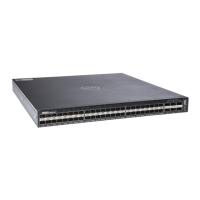
